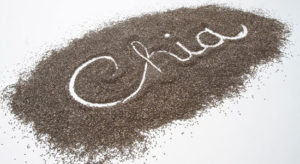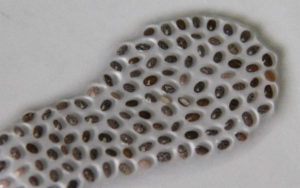The first thing that may come to mind when you hear the word chia is “chia pet”, the 1970’s terracotta clay animal with sprouting green fur growing out the top. Today, from the same plant, chia seeds are consumed for their nutritional value. They are the tiny little black seeds that seem to be in anything claimed as “healthy”; with their many known benefits, chia seeds are well worth adding into your diet.  http://www.magnetmagazine.com/wp-content/uploads/2012/06/ChiaSeeds.jpg The Chia plant originated from Mexico and some parts of South America. Legend has it that the Mayans and Aztecs used them as an energy booster and it was as much of a staple food in their diet as maize. Chia is actually the Mayan word strength. Today the Chia plant is grown in Mexico, Bolivia, Argentina, Ecuador, Nicaragua, Guatemala and Australia. It grows in a variety of climate zones, including: temperate, tropical coastal, desert, tropical rain forest and inter-Andean dry valley. The chia plant is a type of sage from the mint family and grows to be about 5 1/2 feet tall. It has purple, blue or white flowers that form in clusters at the top of the plant in spikes. It prefers moderately fertile well-drained soils.
http://www.magnetmagazine.com/wp-content/uploads/2012/06/ChiaSeeds.jpg The Chia plant originated from Mexico and some parts of South America. Legend has it that the Mayans and Aztecs used them as an energy booster and it was as much of a staple food in their diet as maize. Chia is actually the Mayan word strength. Today the Chia plant is grown in Mexico, Bolivia, Argentina, Ecuador, Nicaragua, Guatemala and Australia. It grows in a variety of climate zones, including: temperate, tropical coastal, desert, tropical rain forest and inter-Andean dry valley. The chia plant is a type of sage from the mint family and grows to be about 5 1/2 feet tall. It has purple, blue or white flowers that form in clusters at the top of the plant in spikes. It prefers moderately fertile well-drained soils.  http://cdn.instructables.com/FW2/KIR9/HGH70QF6/FW2KIR9HGH70QF6.LARGE.jpg The greens of the chia plant can be eaten as is or in salads, and are easy to grow at home. When added to water, chia seeds form a gel like susbatnce that can be used to thicken foods such as smoothies and jam. It's ability to hold on to water is part of why it was used as an endurance food.
http://cdn.instructables.com/FW2/KIR9/HGH70QF6/FW2KIR9HGH70QF6.LARGE.jpg The greens of the chia plant can be eaten as is or in salads, and are easy to grow at home. When added to water, chia seeds form a gel like susbatnce that can be used to thicken foods such as smoothies and jam. It's ability to hold on to water is part of why it was used as an endurance food. 
 http://www.magnetmagazine.com/wp-content/uploads/2012/06/ChiaSeeds.jpg The Chia plant originated from Mexico and some parts of South America. Legend has it that the Mayans and Aztecs used them as an energy booster and it was as much of a staple food in their diet as maize. Chia is actually the Mayan word strength. Today the Chia plant is grown in Mexico, Bolivia, Argentina, Ecuador, Nicaragua, Guatemala and Australia. It grows in a variety of climate zones, including: temperate, tropical coastal, desert, tropical rain forest and inter-Andean dry valley. The chia plant is a type of sage from the mint family and grows to be about 5 1/2 feet tall. It has purple, blue or white flowers that form in clusters at the top of the plant in spikes. It prefers moderately fertile well-drained soils.
http://www.magnetmagazine.com/wp-content/uploads/2012/06/ChiaSeeds.jpg The Chia plant originated from Mexico and some parts of South America. Legend has it that the Mayans and Aztecs used them as an energy booster and it was as much of a staple food in their diet as maize. Chia is actually the Mayan word strength. Today the Chia plant is grown in Mexico, Bolivia, Argentina, Ecuador, Nicaragua, Guatemala and Australia. It grows in a variety of climate zones, including: temperate, tropical coastal, desert, tropical rain forest and inter-Andean dry valley. The chia plant is a type of sage from the mint family and grows to be about 5 1/2 feet tall. It has purple, blue or white flowers that form in clusters at the top of the plant in spikes. It prefers moderately fertile well-drained soils.  http://cdn.instructables.com/FW2/KIR9/HGH70QF6/FW2KIR9HGH70QF6.LARGE.jpg The greens of the chia plant can be eaten as is or in salads, and are easy to grow at home. When added to water, chia seeds form a gel like susbatnce that can be used to thicken foods such as smoothies and jam. It's ability to hold on to water is part of why it was used as an endurance food.
http://cdn.instructables.com/FW2/KIR9/HGH70QF6/FW2KIR9HGH70QF6.LARGE.jpg The greens of the chia plant can be eaten as is or in salads, and are easy to grow at home. When added to water, chia seeds form a gel like susbatnce that can be used to thicken foods such as smoothies and jam. It's ability to hold on to water is part of why it was used as an endurance food. 
http://runningatdisney.com/wp-content/uploads/2012/07/chia-gel.jpg?w=300
MATERIA MEDICA: CHIA SEEDS
Latin name: Salvia Hispanica Family: Lamiaceae Parts used: the seeds Actions: Maintains bone and oral health, stabilizes blood sugar, improves blood pressure and cholesterol levels, anti-inflammatory, promotes nerve transition, increases metabolism and energy production, healthy skin and hair, improves heart health, is a colon cleanser and improves digestive health. Preparation and dosage: You can consume 1-4 tablespoons of the raw seeds daily. You can add them into a smoothie, juice, and water, sprinkle on a salad or hot cereal, make a gel out of it, grind it into a powder or use it for baking or cooking. Uses: Chia seeds have many health benefits and are known as being one of the more recent “coined” super foods. It’s also known for having lots of Omega 3’s, being high in protein and fiber and as an energy booster. Chia is also a good combater of diabetes, the seeds help to slow down digestion and with the gelatin like coating when in a liquid can help to prevent blood sugar spikes. Chia contains a high amount of B vitamins such as thiamin, niacin and riboflavin and foliate, and other nutrients such as calcium, iron, magnesium, manganese, phosphorus and zinc. Cautions: According to Wikipedia, if you are using anticoagulants or aspirin you should be cautious while consuming Chia seeds. Studies show there may be an increased risk of bleeding. Sources:- https://www.mountainroseherbs.com/products/chia-seed/profile
- http://www.huffingtonpost.ca/2013/06/03/chia-seed-benefits-_n_3379831.html
- http://en.wikipedia.org/wiki/Salvia_hispanic
- http://www.seedguides.info/chia-seeds/
- http://whatscookingamerica.net/CharlotteBradley/Chai-Seeds.htm
- http://www.uky.edu/Ag/CCD/introsheets/chia.pdf



